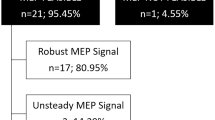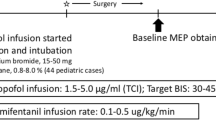Abstract
Objective
This study documents the monitorability using different anesthesia regimes and accuracy of muscle motor evoked potentials (mMEPs) in children ≤2 years of age undergoing tethered cord surgery (TCS).
Methods
Intraoperative mMEP monitoring was attempted in 100 consecutive children, ≤2 years of age, undergoing TCS. MEP monitoring was done under 4 different anesthetic regimes: (Total intravenous anesthesia (TIVA); balanced anesthesia with sevoflurane and ketamine; balanced anesthesia with isoflurane and ketamine; and balanced anesthesia with sevoflurane). Factors analyzed for their effect on monitorability were: age, neurological deficits, type of anesthesia, and the number of pulses used for stimulation.
Results
Baseline mMEPs were obtained in 87% children. Monitorability of mMEPs was similar in children ≤1 year and 1-2 years of age (85.7% and 87.5%). In multivariate analysis, anesthesia regime was the only significant factor predicting presence of baseline mMEPs. Children undergoing TIVA (p=0.02) or balanced anesthesia with a combination of propofol, sevoflurane, and ketamine (p=0.05) were most likely to have baseline mMEPs. mMEPs had a sensitivity of 97.4%, specificity of 96.4%, negative predictive value of 98.2% and accuracy of 96.8%.
Conclusions
Baseline mMEPs were obtained in >85% of children ≤2 years of age including those who had motor deficits. TIVA and balanced anesthesia with sevoflurane and ketamine are ideal for mMEP monitoring. mMEPs have a high accuracy although, false positive and false negative results can occasionally be experienced.




Similar content being viewed by others
References
Aydinlar EI, Dikmen PY, Kocak M, Baykan N, Seymen N, Ozek MM (2019) Intraoperative neuromonitoring of motor evoked potentials in infants undergoing surgery of the spine and spinal cord. J Clin Neurophysiol 36(1):60–66. https://doi.org/10.1097/WNP.0000000000000523
Şenköylü A, Zinnuroğlu M, Börçek A, Aktaş E, Güngör İ, Beyazova M (2017) Comparison of multimodal intraoperative neurophysiological monitoring efficacy in early childhood and school aged children undergoing spinal surgery. Acta Orthop Traumatol Turc 51(1):49–53. https://doi.org/10.1016/j.aott.2016.12.005
Lieberman JA, Lyon R, Feiner J, Diab M, Gregory GA (2006) The effect of age on motor evoked potentials in children under propofol/isoflurane anesthesia. Anesth Analg 103(2):316–321. https://doi.org/10.1213/01.ane.0000226142.15746.b2
Fulkerson DH, Satyan KB, Wilder LM, Riviello JJ, Stayer SA, Whitehead WE, Curry DJ, Dauser RC, Luerssen TG, Jea A (2011) Intraoperative monitoring of motor evoked potentials in very young children. J Neurosurg Pediatr 7(4):331–337. https://doi.org/10.3171/2011.1.PEDS10255
Vora TK, Girishan S, Moorthy RK, Rajshekhar V (2021) Early and long-term surgical outcomes in 109 children with lipomyelomeningocele. Childs Nerv Syst. https://doi.org/10.1007/s00381-020-05000-y Epub ahead of print
McIntyre IW, Francis L, McAuliffe JJ (2016) Transcranial motor evoked potentials are more readily acquired than somatosensory evoked potentials in children younger than 6 years. Anesth Analg 122(1):212–218. https://doi.org/10.1213/ANE.0000000000001044
Macdonald DB (2006) Intraoperative motor evoked potential monitoring: overview and update. J Clin Monit Comput 20(5):347–377. https://doi.org/10.1007/s10877-006-9033-0
Sala F, Squintani G, Tramontano V, Arcaro C, Faccioli F, Mazza C (2013) Intraoperative neurophysiology in tethered cord surgery: techniques and results. Childs Nerv Syst 29(9):1611–1624. https://doi.org/10.1007/s00381-013-2188-3
Yi YG, Kim K, Shin HI et al (2019) Feasibility of intraoperative monitoring of motor evoked potentials obtained through transcranial electrical stimulation in infants younger than 3 months. J Neurosurg Pediatr 23(6):1–9. https://doi.org/10.3171/2019.1.PEDS18674
Journée HL, Polak HE, de Kleuver M, Langeloo DD, Postma AA (2004) Improved neuromonitoring during spinal surgery using double-train transcranial electrical stimulation. Med Biol Eng Comput 42(1):110–113. https://doi.org/10.1007/BF02351019
Hayashi H, Kawaguchi M, Yamamoto Y et al (2008) Evaluation of reliability of post-tetanic motor-evoked potential monitoring during spinal surgery under general anesthesia. Spine (Phila Pa 1976) 33(26):E994–E1000. https://doi.org/10.1097/BRS.0b013e318188adfc
Fekete G, Bognár L, Novák L (2019) Surgical treatment of tethered cord syndrome-comparing the results of surgeries with and without electrophysiological monitoring. Childs Nerv Syst 35(6):979–984. https://doi.org/10.1007/s00381-019-04129-9
Rajshekhar V, Velayutham P, Joseph M, Babu KS (2011) Factors predicting the feasibility of monitoring lower-limb muscle motor evoked potentials in patients undergoing excision of spinal cord tumors. J Neurosurg Spine 14(6):748–753. https://doi.org/10.3171/2011.1.SPINE10310
Sala F, Palandri G, Basso E, Lanteri P, Deletis V, Faccioli F, Bricolo A (2006) Motor evoked potential monitoring improves outcome after surgery for intramedullary spinal cord tumors: a historical control study. Neurosurgery 58(6):1129–1143. https://doi.org/10.1227/01.NEU.0000215948.97195.58
El-Hawary R, Sucato DJ, Sparagana S et al (2006) Spinal cord monitoring in patients with spinal deformity and neural axis abnormalities: a comparison with adolescent idiopathic scoliosis patients. Spine (Phila Pa 1976) 31(19):E698–E706. https://doi.org/10.1097/01.brs.0000232707.98076.37
Lotto ML, Banoub M, Schubert A (2004) Effects of anesthetic agents and physiologic changes on intraoperative motor evoked potentials. J Neurosurg Anesthesiol 16(1):32–42. https://doi.org/10.1097/00008506-200401000-00008
Sloan T (2010) Anesthesia and intraoperative neurophysiological monitoring in children. Childs Nerv Syst 26(2):227–235. https://doi.org/10.1007/s00381-009-1023-3
Bithal PK (2014) Anaesthetic considerations for evoked potentials monitoring. J Neuroanaesthesiol Crit Care 1(01):002–012
Inoue S, Kawaguchi M, Takashi S, Kakimoto M, Sakamoto T, Kitaguchi K, Furuya H, Morimoto T, Sakaki T (2002) Intraoperative monitoring of myogenic motor-evoked potentials from the external anal sphincter muscle to transcranial electrical stimulation. Spine (Phila Pa 1976) 27(21):E454–E459. https://doi.org/10.1097/00007632-200211010-00018
Deiner SG, Kwatra SG, Lin HM, Weisz DJ (2010) Patient characteristics and anesthetic technique are additive but not synergistic predictors of successful motor evoked potential monitoring. Anesth Analg 111(2):421–425. https://doi.org/10.1213/ANE.0b013e3181e41804
Pratheesh R, Babu KS, Rajshekhar V (2014) Improvement in intraoperative transcranial electrical motor-evoked potentials in tethered cord surgery: an analysis of 45 cases. Acta Neurochir 156(4):723–731. https://doi.org/10.1007/s00701-014-1999-7
Noonan KJ, Walker T, Feinberg JR, Nagel M, Didelot W, Lindseth R (2002) Factors related to false- versus true-positive neuromonitoring changes in adolescent idiopathic scoliosis surgery. Spine (Phila Pa 1976) 27(8):825–830. https://doi.org/10.1097/00007632-200204150-00009
Jin SH, Chung CK, Kim CH, Choi YD, Kwak G, Kim BE (2015) Multimodal intraoperative monitoring during intramedullary spinal cord tumor surgery. Acta Neurochir 157(12):2149–2155. https://doi.org/10.1007/s00701-015-2598-y
Author information
Authors and Affiliations
Contributions
The study conception, design and supervision were done by Vedantam Rajshekhar. Material preparation, data collection, and analysis were performed by Bijesh and Krothapalli Srinivasa Babu. The first draft of the manuscript was written by Bijesh, Mariappan Ramamani and Georgene Singh. Manuscript was reviewed and edited by Krothapalli Srinivasa Babu and Vedantam Rajshekhar. All authors read and approved the final manuscript.
Corresponding author
Ethics declarations
Conflict of interest
The authors declare that they have no conflict of interest.
Additional information
Publisher’s note
Springer Nature remains neutral with regard to jurisdictional claims in published maps and institutional affiliations.
Rights and permissions
About this article
Cite this article
Nair, B.R., Ramamani, M., Singh, G. et al. Feasibility and diagnostic accuracy of intra-operative monitoring of motor evoked potentials in children <2 years of age undergoing tethered cord surgery: results in 100 children. Childs Nerv Syst 37, 2289–2298 (2021). https://doi.org/10.1007/s00381-021-05128-5
Received:
Accepted:
Published:
Issue Date:
DOI: https://doi.org/10.1007/s00381-021-05128-5




